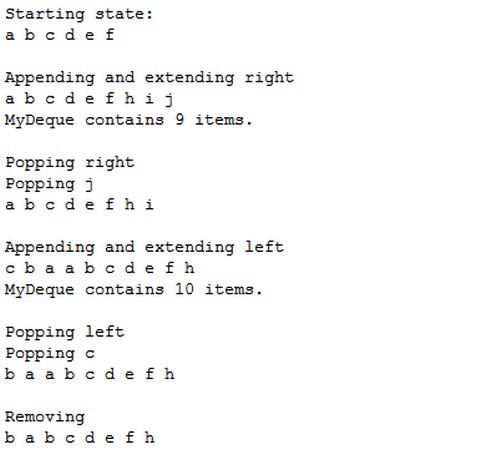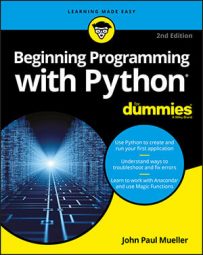deque is simply a queue where you can remove and add items from either end. In many languages, a queue or stack starts out as a deque. Specialized code serves to limit deque functionality to what is needed to perform a particular task.When working with a deque, you need to think of the deque as a sort of horizontal line. Certain individual functions work with the left and right ends of the deque so that you can add and remove items from either side. The following steps help you create an example that demonstrates deque usage. This example also appears with the downloadable source code as DequeData.py.
- Type the following code into Notebook — pressing Enter after each line.
import collectionsMyDeque = collections.deque("abcdef", 10)print("Starting state:")for Item in MyDeque:print(Item, end=" ")print("\r\n\r\nAppending and extending right")MyDeque.append("h")MyDeque.extend("ij")for Item in MyDeque:print(Item, end=" ").format(len(MyDeque)))print("\r\nPopping right")print("Popping {0}".format(MyDeque.pop()))for Item in MyDeque:print(Item, end=" ")print("\r\n\r\nAppending and extending left")MyDeque.appendleft("a")MyDeque.extendleft("bc")for Item in MyDeque:?print(Item, end=" ")print("\r\nMyDeque contains {0} items.".format(len(MyDeque)))print("\r\nPopping left")print("Popping {0}".format(MyDeque.popleft()))for Item in MyDeque:print(Item, end=" ")print("\r\n\r\nRemoving")MyDeque.remove("a")for Item in MyDeque:print(Item, end=" ")The implementation of
dequeis found in thecollectionspackage, so you need to import it into your code. When you create adeque, you can optionally specify a starting list of iterable items (items that can be accessed and processed as part of a loop structure) and a maximum size, as shown.A
dequedifferentiates between adding one item and adding a group of items. You useappend()orappendleft()when adding a single item. Theextend()andextendleft()functions let you add multiple items. You use thepop()orpopleft()functions to remove one item at a time. The act of popping values returns the value popped, so the example prints the value onscreen. Theremove()function is unique in that it always works from the left side and always removes the first instance of the requested data.Unlike some other collections, a deque is fully iterable. This means that you can obtain a list of items by using a
forloop whenever necessary. - Click Run Cell.
Python outputs the information (the screenshot shows only the output and none of the code).
 A deque provides the double-ended functionality and other features you’d expect.
A deque provides the double-ended functionality and other features you’d expect.Following the output listing closely is important. Notice how the size of the
dequechanges over time. After the application pops the j, thedequestill contains eight items. When the application appends and extends from the left, it adds three more items. However, the resultingdequecontains only ten items. When you exceed the maximum size of adeque, the extra data simply falls off the other end.

